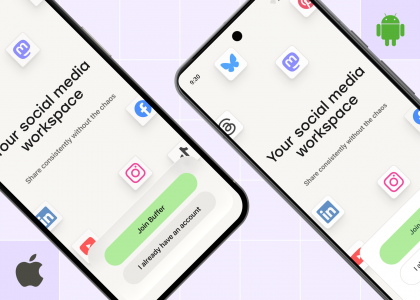The secret to engaging social media posts has been in front of you this whole time.
And it’s not about having a ton of followers or decoding a complex algorithm.
Instead, it all boils down to your opening words. Copywriters call it a ‘hook,’ and learning how to write social media hooks can be the difference between your followers scrolling past your post or stopping in their tracks to see what you have to say.
As a copywriter, crafting engaging hooks is part of my job, but I don’t just save them for client work. I also use these strategies on my own social media accounts. And despite only having ~2,500 followers on LinkedIn, my posts often reach tens of thousands of people, who then engage and often turn into leads and followers.
And today, I want to share my framework for writing social media hooks that can increase engagement regardless of your account size. I’ll also cover six of my favorite types of hooks that I often lean on to write social posts that reach far beyond my followers.
What is a social media hook?
A hook (or a “lede” in journalism) is the first few sentences of your post, like the first few sentences of an Instagram post or your first lines in a TikTok video.
Take this Instagram Reel from stylist Christie Moeller. Christie starts off by saying, “buckle up, because this fall trend is not for the faint-hearted.” The audio, combined with her caption (“the fall trend everyone is talking about”), builds intrigue and makes you want to tune in to find out what fall trend she’s referencing.
(If you’re anything like me and need to know the trend, it’s silk scarfs paired with baseball caps. You can thank Christie for that tidbit!)
And that’s exactly what your social media hook should do. It should get people to perk up and pay attention (and, ultimately, engage with your content).
But without a strong hook, you risk people scrolling past your content and missing your message. And let’s face it, that’s the last thing you want after pouring your time and energy into content creation.
Let’s take a look at another great social media hook from entrepreneur Alex Friedman.
My friend’s dad built a multi-million dollar waste management company. Today, he has major clients like 7-Eleven, Costco, and others.
The other day, he was telling us about one of his first sales meetings back when he was just starting out, over 30 years ago.
He went to this…
— Alex Friedman 🤠 (@heyalexfriedman) September 16, 2024
The first two paragraphs (three sentences) make you want to click the “show more” button to dive into the full story—and find out how her friend’s dad landed such big-name clients.
And when you click “show more,” Alex follows up with the story she promised in her hook.
That’s important: your content must support your hook. Otherwise, you risk annoying your audience by underdelivering on your promise.
Thankfully, you can write hooks that are both accurate and enticing without resorting to sensationalism.
Here’s how:
How to write great social media hooks
Follow my quick and easy four-step framework to write social media hooks that draw people in, encourage them to engage, and increase the chance they’ll follow you for more great content.
1. Pick your topic
Your hook has the best chance of working if it leads into a topic that gets your audience excited.
Here’s an example of my LinkedIn post that fell flat simply because the topic and my audience didn’t align.
At the time, my audience was mostly freelance writers, and many of them didn’t have email lists or lead magnets. And they weren’t interested in the topic of this post no matter how interesting the hook may’ve been.
So, pinpoint what your audience likes to see on social media. I do this by:
Reviewing past high-performing social media posts and seeing which topics get the most engagement (likes, comments, shares, etc.)Heading to my competitors’ social media profiles and seeing which topics have been successful for them based off engagementGoing to a niche-relevant subreddit and sorting the posts by most popular and seeing which topics generate the most engagement (e.g., sort by “Top” and “This Year.”)
With a topic selected you’re ready to choose your hook’s angle.
2. Select an angle
Your angle dictates how you write your hook. Will you rely on curiosity? The promise of a story?
There are many different angles you can take, but today, we’re going over six psychological techniques that will help spark your reader’s desire to consume your entire post.
I also recommend downloading my free hook template guide. You’ll get a few different hook templates for each angle to help you get into a groove of writing your own hooks.
Aside: Some writers write the body copy (the content that follows the hook) of the social media post before the hook. I personally find it easier to start with my hook. However, use this chance to get to know yourself as a writer and experiment to see which flows best.
Open loop
Open loops, often referred to as curiosity gaps, involve presenting a concept to your reader without fully exploring it until later in your caption. They’re effective because curiosity drives people, and quite honestly, the discomfort of not knowing entices people to stay engaged to get their answer.
Your favorite books and T.V. shows use open loops all the time, especially in the form of cliffhangers. (Tell me honestly how many times you’ve said “just one more chapter/episode!” and next thing you know, three hours have passed…)
Open loops work great for nearly any type of post where you promise to give the reader something, like a tip, a lesson, or a gift (think promo codes or freebies).
Here’s an example of an open loop in action. I present my idea (highlighted in blue). But I don’t reveal the reason right away. Instead, I talk a bit about AI. It isn’t until a few paragraphs down that I reveal the why to my idea (the second blue highlight). And after revealing it, I take a few more paragraphs to round off the post.
This post got nearly 60,000 impressions. (At the time of writing it, I had under 2,500 followers. So I’m happy with this level of engagement for my account size.)
Tip for writing posts using an open loop hook:
Start with a question or bold statement that hints at something intriguing and spark curiosity by sharing just enough to hook the readerDelay the reveal of your hook’s promise for several paragraphs to keep the reader engagedEnsure the payoff is valuable when you close the loop (i.e., your resolution should be worth the wait)
Bandwagon effect
The bandwagon effect is the desire for people to do something because others are doing it. And you don’t need to go far to find examples of the bandwagon effect in the wild. Just take a look at any TikTok trend—like the feta cheese pasta recipe that caused demand for feta cheese to spike so high that retailers couldn’t keep it stocked.
This type of hook works well when you want people to take some form of action. Like asking them to share a story. As more people share their stories, more will hop on the bandwagon to share their own.
Or you can use it to grow your email list, like I did.
And despite lower reach and engagement on this post, I had a huge increase in people signing up for my email list through my quiz:
Why? Because people wanted to hop on the bandwagon and take the quiz for themselves after they had read that over 100 writers had already done so.
Tip for writing posts using a bandwagon effect hook:
Emphasize popularity by using numbers (i.e., “200+ people asked me about…”) or words like “countless” and “many” (just make sure you’re truthful with your phrasing)Use phrases like “be part of,” “join,” “add your voice to,” and “become one of” to signal community Create a sense of momentum by highlighting an ongoing trend. For example, “Have you tried the viral X?” or “More and more people are getting involved every day”Include a strong CTA to keep momentum going (i.e., “Share your story below to be part of the conversation”
Storytelling
Humans are wired to crave, enjoy stories and seek them out. And the promise of an interesting story is often hard to resist.
So, use your hook to do just that: promise an interesting story your audience won’t want to miss.
Remember our earlier example of the story from Alex?
Her hook leads straight into an interesting story. But you don’t need to worry about developing a plot or coming up with a lengthy story if that’s not your jam. There are plenty of storytelling formulas you can lean into to get your point across.
Take a look at one of my own hooks that leads into a point-form story detailing my journey to writing:
The point-form approach works well if your story is long and complex (like mine above). This way, you can distill it into bite-sized bullet points.
Just make sure that any story you share is relevant to your audience. You might have lots of interesting stories to share, but they aren’t all interesting to the people who follow you. If you’re unsure which stories to tell, take a look into your competition to see which stories have performed well for them.
Tip for writing a post using a storytelling hook:
Start with the moment of highest tension—the climax—or moment of highest pleasure—the resolution—to get your audience’s attention (in my example above, I started with tension that relates to my audience’s struggle)Consider teasing the story’s outcome to build curiosity about how it unfolds (hello, open loop!)Keep it simple—even a brief anecdote can grab attention without needing a full plot
Social proof
Social proof is when people copy the actions of others like them. It can give people a sense of direction during times of uncertainty, and you can use social proof to reinforce why someone might want to read/engage with your social media post.
Social proof is another hook that works well when you’re trying to give advice (and want to seem credible) or when you want to promote an offer.
In my LinkedIn post, I name-dropped a couple of my most notable clients. Someone scrolling might see these recognizable names and decide to read my post to figure out how they can also land similar clients.
Tips for writing a post using a social proof hook:
Share impressive statistics related to your postLead with a testimonial from a client/customerShowcase results from your clients/customersShare awards or recognition you’ve received
Contrarian statements
A contrarian statement challenges popular beliefs. They might come across as shocking, and, as a result, can capture the attention of people scrolling. However, write contrarian statements with care. Your goal isn’t to offend but simply to take a different stance that would catch someone off guard.
You might decide to use a contrarian statement to further position yourself as a leader within your niche. Boldly straying from conventional views helps you demonstrate confidence and expertise—and can make you more memorable thanks to a psychological phenomena known as the bizarreness effect. (The bizarreness effect is the tendency to remember things that stand out.)
When I took a contrarian approach, I decided to flip an old piece of advice on its head and told my audience that the way to become a better writer is not to write more often (despite popular advice):
In the post, I provided my alternative view, including my reasoning.
Tip for writing a post using a contrarian statement hook:
Pick a common belief you disagree with and challenge itMake sure your belief isn’t offensive (you don’t want to alienate your audience)Provide evidence to support your claim and explain your stance
Fear of missing out (FOMO)
When people think they might miss out on something (such as losing out on important advice if they decide to scroll past your post), they may be more inclined to stick around, engage with it, and even save it for later.
This type of hook typically works when you share advice that deals with your audience’s deepest fear or if you want to share something time-sensitive (like a limited-time sale).
For this post, I leaned into a common fear my audience has (being stagnant in your career growth), and throughout the post, I shared one tip they could use to avoid my same mistake.
Tip for writing a post using a FOMO hook:
Highlight limited-time offers or information your audience won’t want to missShowcase the benefits of taking actionUse phrases like “miss out” and “last chance” to convey urgency
3. Write your hook
Write at least three versions of your hook with the angle you’ve chosen, and pick the hook you think will perform the best.
Don’t feel too much pressure here—the more hooks you write (and the more hooks you publish) the easier it will be to identify the best-performing one in the future.
And if you’re still stuck? Grab my free hook templates to help you get started.
Here are some final tips for writing a hook regardless of the angle you go with:
Use power words to tap into your audience’s emotionsKeep it short. Long sentences may come across as difficult to read and can turn away your audience.Make sure your hook isn’t embellishing and that you can follow through on what you promise in your hook
Aside: You can also combine multiple angles! For example, use a contrarian statement paired with social proof to further validate your position. As you begin writing hooks, let your creativity fly and experiment with different ones to see how your audience reacts.
4. Write the rest of your caption (and a CTA)
Your hook can serve as your guiding north star to write your caption (and it’s why I like to write my hook before the rest).
And when you write your hook first, you can use tools like Buffer’s AI Assistant to draft your caption. Just give the AI instructions like who your audience is, what your post is about, and what hook it should use to start off your post.
Finally, round off your post with a call-to-action (CTA) and tell your audience what they should do: leave a comment? Sign up for your email list? Make it clear so you can get the most engagement possible.
Analyze and iterate
Writing is an iterative process, so take an experimental mindset when you start writing hooks for your posts and try to understand what works and what doesn’t.
For example, my analytics show spikes in impressions on three specific days. So, I’d go back and check which posts correlate with those days.
Then, I’d try to draw parallels between posts that perform well and ones that don’t by asking myself:
Are there any similarities in the posts that perform well? And if so, how can I replicate that for future posts?Can I rework a low-performing post’s hook with a different angle to see if it performs better?What happens if I test two of the same posts, a few weeks apart, with two different hooks?
Ask yourself these same questions with your analysis. And each time you post, you’ll learn more about your audience and the kind of hooks they enjoy and want to engage with.
Time to write your own social media hooks
Once you pick your post’s topic you’re ready to draft its hook. Remember: these tips work for written social posts or when you need to write scripts for video content like Reels or TikToks.
Give these hooks a try today and see which ones bring you the most engagement and growth!






